Electric vehicles (EVs) have seen remarkable growth, especially in the automotive and public transportation sectors. However, their up-front cost hampers further expansion. Addressing this challenge involves reducing the most substantial fixed cost element: the battery. This Viewpoint explores the practice of repurposing as an option for reducing costs. Despite great potential, the market for repurposing is still evolving, presenting both challenges and opportunities.
While recycling is a common practice for used EV batteries, repurposing has emerged as a potentially more beneficial option, generating additional revenue, reducing waste management costs, and contributing to lowering the total cost of manufacturing and operating EVs.
Batteries in EVs can have a remarkably long lifespan. However, once they reach 70%-80% of their original capacity (a battery’s state of health [SOH]), they are deemed nonviable in the vehicle. Repurposing involves processes like collection, discharge, assessment, disassembly, and reconfiguration of a battery into a new application. This taps into the remaining useful life of the battery, generating additional revenue and increasing its overall economic value.
While current practices involve shipping batteries to recycling plants once removed from a vehicle, the evolving landscape, including new battery chemistries — lithium iron phosphate (LFP) versus nickel manganese cobalt (NMC) — and changing regulations, suggests a potential shift. Investors are now allocating capital toward both recycling and emerging second-life opportunities. Second-life batteries (SLBs) find applications in stationary systems, combined with renewable energy sources, grid support, and behind-the-meter-electricity storage for residential, commercial, and industrial properties. Figure 1 shows the lifecycle of a vehicle battery, including possible recycling and repurposing processes and second-life applications.
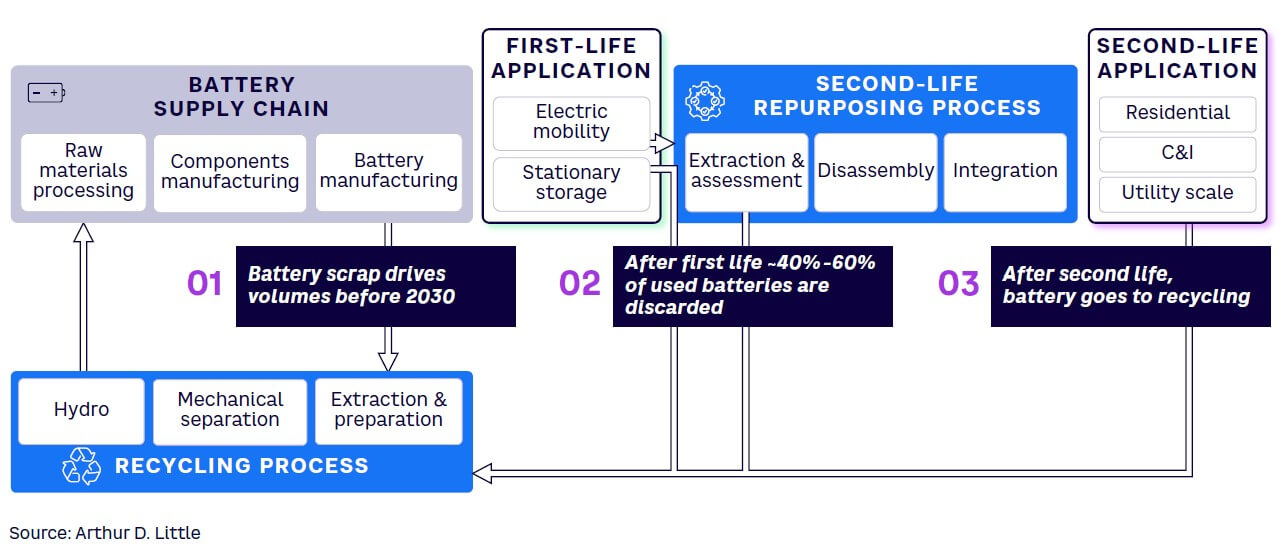
In 2022, EVs achieved a historic milestone, accounting for over 10% of global vehicle sales. China led other regions, with EVs representing 19% of all sales, followed by Europe with 11%. Beyond being a step toward a more sustainable future, these figures indicate a tipping point in mass EV adoption. As more EVs approach the end of their lifecycle, attention shifts to handling the batteries of retired vehicles. By 2030, we expect more than 17 GWh of EV batteries to become available for repurposing from cars, buses, vans, and trucks, as shown in Figure 2.
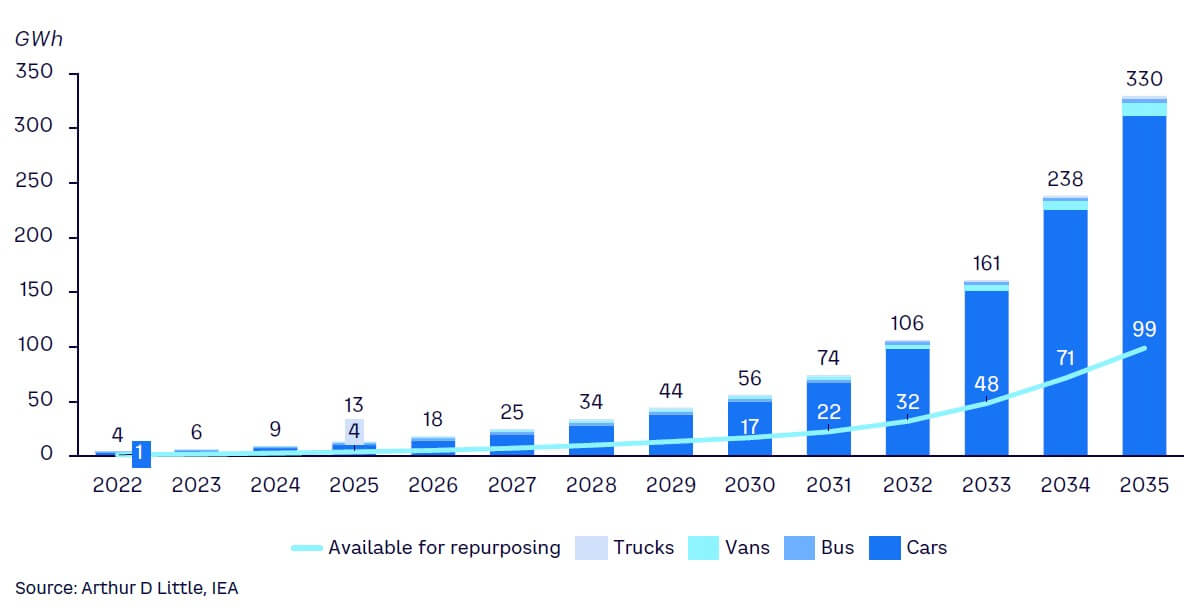
Battery costs still constitute close to 40% of total EV costs across the industry, a significant factor in EV manufacturing. With lithium-ion (Li-ion) battery technology continuing to dominate, global raw material prices have surged over the last three years. Lithium commodity prices have increased over 1,000% since 2020, resulting in a notable uptick in Li-ion battery pack prices. Prices for other raw materials used in battery manufacturing have also surged in the recent past (see Figure 3). This has been caused by the expanding demand for EVs coupled with the inelastic nature of the mining industries (i.e., limited ability of supply expanding when prices increase). Reusing batteries becomes attractive as a means of price hedging and ensuring a reliable supply for energy storage providers, especially with the rise of lower-value chemistries like LFP.
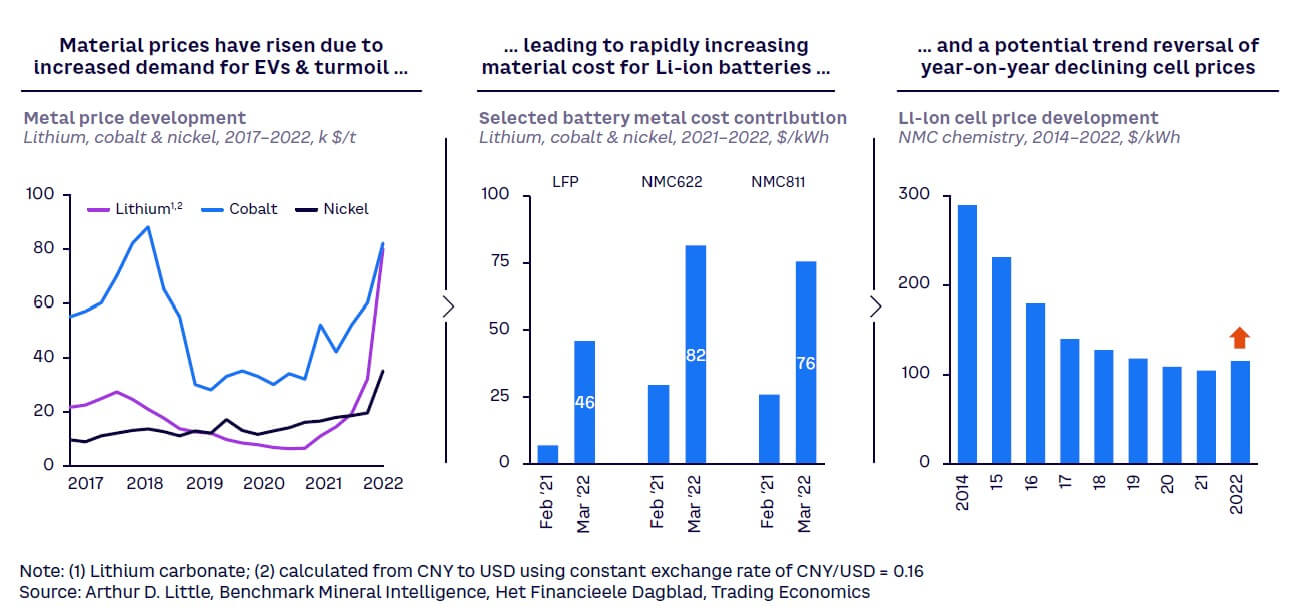
As illustrated in Figure 4, there are five main Li-ion battery cathode chemistries: (1) NMC (and NMCA, a variation containing aluminum), (2) NCA (nickel cobalt aluminum oxide), (3) NMA (nickel cobalt manganese aluminum oxide), (4) LCO (nickel- and/or cobalt-heavy), and (5) LFP (iron- and phosphate-based). While NMCs dominate today’s EV market, LFPs gain traction in personal EVs, electric buses, and trucks. The traditional route has been to recycle those materials to recapture the most value from the battery. However, the less valuable materials in LFP batteries (consisting mainly of iron and phosphate) raise concerns about the economic feasibility of recycling, making second-life applications an appealing alternative.
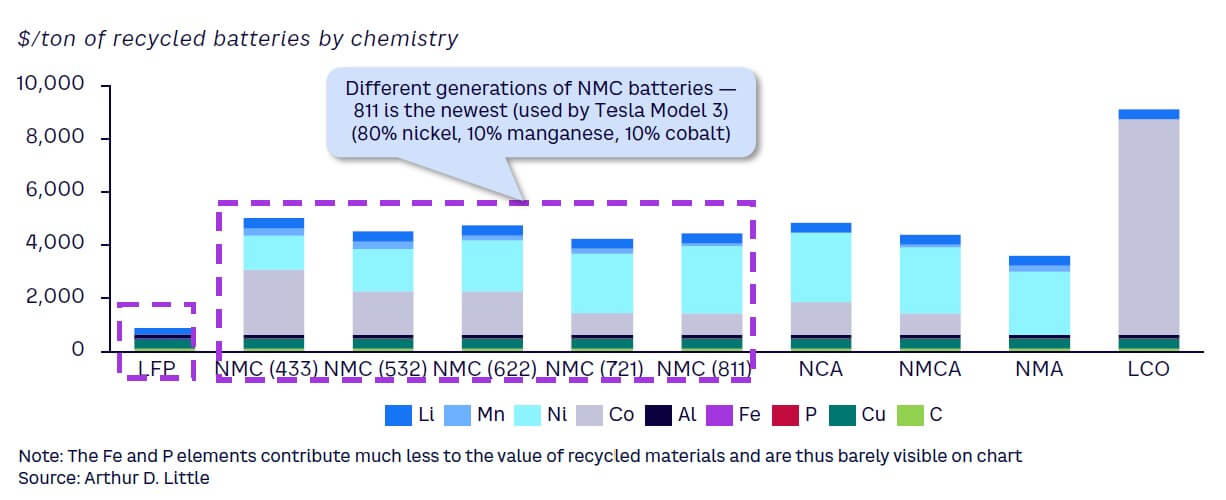
Historically, battery-recycling capacity in the US and the EU has been limited, with two-thirds of the recycling capacity located in East Asia at the end of 2021. Most used batteries were shipped to these facilities to be recycled. More recently, given that recycling is increasingly recognized as a key economic activity and regulations favor it, a variety of players interested in tackling Li-ion battery recycling have emerged worldwide. These include tech-focused start-ups, chemical and waste management companies, as well as battery and automotive manufacturers striving for an integrated approach. Examples of new facilities include Redwood Materials’s recycling plant in Reno, Nevada, USA, and Umicore’s facility in Hoboken, Belgium. Although specific techniques may differ, the concept of recycling EV batteries remains consistent across major players, such as Redwood Materials and Li-Cycle in North America and Glencore and Umicore in Europe. Multiple collaborations are forming with players aiming to establish the right partnerships to cover several steps of the battery-recycling value chain.
The appeal of recycling to these companies lies in extracting valuable materials from used batteries that can then be utilized in new products, including vehicle batteries, creating an element of a circular economy in the EV sector. This presents a potentially profitable business case, contingent on the value of recovered materials and the disposal fees paid by original equipment manufacturers (OEMs). However, it falls short in capturing the value from any potential remaining useful life within the original batteries.
In contrast, repurposing captures the value of end-of-life EV batteries by reconfiguring used batteries into a useful electricity-storage product. This not only generates more revenue but also reduces costs for battery owners (e.g., vehicle OEMs). Additional revenue streams can be established by selling used batteries to a “repurposer” (e.g., energy storage companies) or selling repurposed products (e.g., industrial storage solutions) directly to end users. The former can be achieved through a longer-term partnership with a repurposer. Consequently, the initial cost of battery manufacturing can be spread over an extended period of revenue generation. In this way, second-life applications contribute to the reduction of waste management costs for OEMs.
To retain ownership of batteries, maximize profitability, and reduce the overall cost to the consumer, OEMs are implementing battery-leasing programs. These initiatives separate the battery from the vehicle’s sale, resulting in a more affordable vehicle for the customer, while OEMs retain ownership of the batteries. This approach gives OEMs the flexibility to become repurposers and/or asset operators themselves or enter partnerships with energy specialists. In doing so, they diversify their business portfolios into clean energy, earning a premium on their valuation multiple compared to their peers.
The SLB supply chain is in its nascent stages. The EU’s new battery regulation aims to structure the ecosystem by assigning responsibilities to battery producers for end-of-life treatment. By 2026, repurposing is expected to become less costly, supported by the EU’s requirement of battery passports for industrial and EV batteries.
For example, UK-based Connected Energy has taken an early leadership position by forming partnerships across the value chain despite market ambiguity (see Figure 5). The company connects individual, unchanged battery packs from OEMs and operates them as part of a battery energy storage system (BESS) unit and has introduced several related pilot projects. The approach aims to overcome market ambiguity by providing a missing link between the original battery owners (OEMs) and second-life users (i.e., utilities, commercial and industrial [C&I] companies, and residential storage providers).
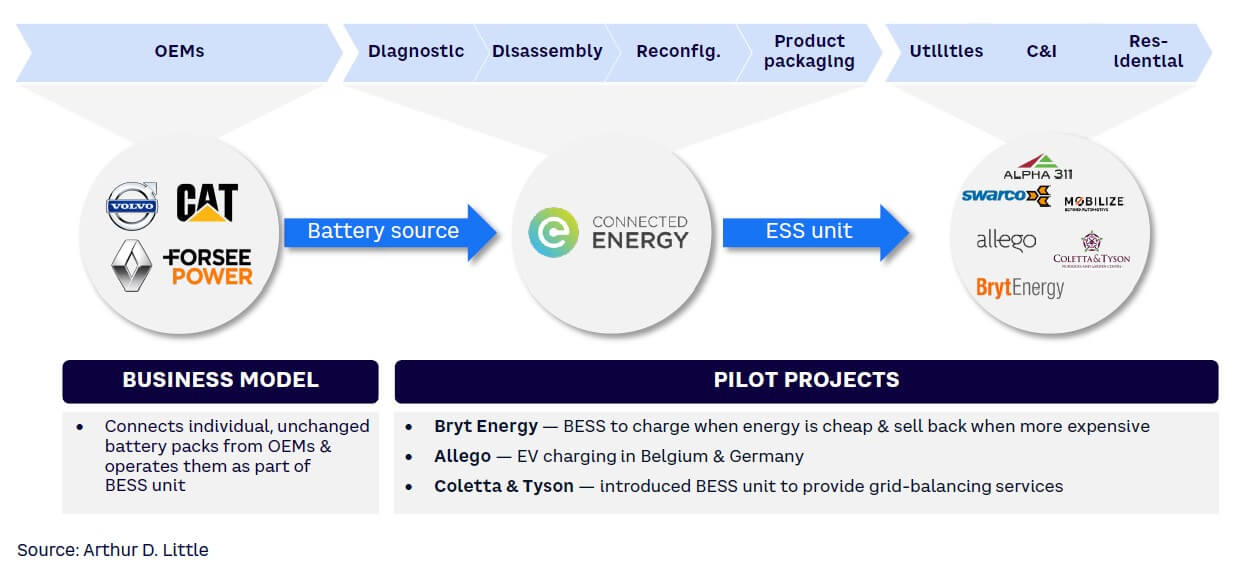
Similar ecosystems are emerging globally: